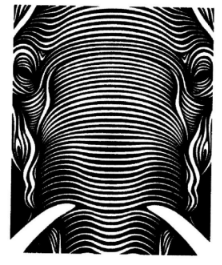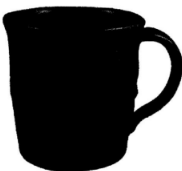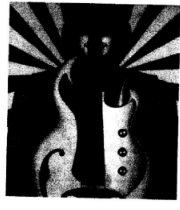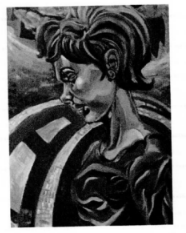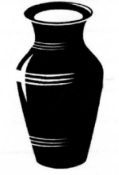Instructions to candidates
- This paper consists of three sections: A, B and C
- Answer all questions in section A and B
- Answer any one question from section C
- Where drawings and diagrams are appropriate, they should be included within the text of your answers.
- Candidates should answer the questions in English
SECTION A (20 marks)
Answer all the questions in this section in the spaces provided.
-
- Study the artwork below
- Identify the most prominent element used in the artwork. (1 mark)
- State two uses of the element mentioned in (i) above. (1 mark)
-
- Outline two functions of traffic signs. (2 marks)
- Traffic signs are colour coded to guide road users; explain the meaning of each of the following colours as used in the signs:
Blue; brown. (2 marks)
- Describe stippling as a process in art. (1 mark)
- Define a thumbnail in art and state its role. (2 marks)
- Describe the term prototype as applied in design. (2 marks)
- Outline the symbolic meaning of the following colours;
- Black. (1 mark)
- Grey (1 mark)
- Red.. (1 mark)
- What is a colossal statue? (2 marks)
- Identify two techniques that were used to decorate the pottery article below. (2 marks)
- Name the tool that is used in jewellery making to secure a clasp on one end of a beading wire. (1 mark)
- State the function of a beater in weaving. (1 mark)
- Study the artwork below
SECTION B (25 marks)
Answer all questions from this section in the spaces provided
- In the space provided below make a quick sketch of a torn sport shoe (5 marks)
-
- What is corporate identity? ( 1 mark)
- List and analyse four basic corporate identity elements (4 marks)
-
-
- Name the intaglio printmaking process that is used to create tonal prints. (1 mark)
- Describe the intaglio printing technique. (2 marks)
- Write the word APEX as it would appear in a linoleum block for printing. (2 marks)
-
-
-
- What is balance? (1 mark)
- Identify and describe the type of balance portrayed in the artwork below. (2 marks)
- Explain the importance of a viewfinder in art. (2 marks)
-
-
- Contrast between a selvedge and raw edge of a woven fabric. (2 marks)
- Identify two characteristics and two uses of an open work weave. (3 marks)
SECTION C (15 marks)
Answer any one question from this section
Write your answers in the space provided after question 9.
- Analyse the artwork below and;
- State the importance of critique in art? (3 marks)
- Critique the artwork using the four components of artistic criticism. (12 marks)
- The illustration below is a clay vase.
Discuss the steps of making the vase in slab technique using a template and a hump round mould. (15 marks) -
- Outline and describe two approaches of drawing (3 marks)
- Illustrate the process of drawinig using grid llines (12 marks)

MARKING SCHEME
SECTION A (20 marks)
-
-
- The most prominent element used in the artwork is a line. 1x1=1 mark
- Two uses of the element mentioned in (1)
- Line control a viewer's eye.
- It describe edges/ shapes/define form.
- It indicates form as well as movement; indicate value and a light source in drawing, Lines can be used to represent objects themselves.
- Moods, feelings and emotions
- Create illusion of depth
Any 2 x ½ = 1 mark
Total = 2 marks
-
- Two functions of traffic signs;
- Control the flow of traffic,
- Warn motorists of hazards ahead,
- Guide to destination, and inform of roadway services.
Any 1x1=1 mark
- Meaning of colours used in road signs.
- BLUE - motorist service (e.g., gas station, food, hotels) 1x 1 = 1 mark
- BROWN - recreational, historic, or scenic site. 1x 1 = 1 mark
Total = 2 marks
- Two functions of traffic signs;
- Description of stippling as a process in art;
- It is the creation of a pattern simulating varying degrees of solidity or shading by using small dots in drawing, painting, and engraving,
- a technique that practices marking a surface with numerous small dots or specks
1x1 = 1 mark
- Definition of thumbnail and its role in art;
Definition; It's a tiny quick sketch drawn on paper preliminary design used to explore ideas quickly, quick sketches allowing rapid idea iteration. OR It is a small image representation of a larger image used in graphic design
1x1=1 mark
Role; It aids in planning an overall layout or composition allowing rapid idea iteration.
1x1=1 mark
Total = 2 marks - A prototype is a "hand-built" model/ rudimentary working model of a product that represents a manufactured (casily replicable) product sufficiently for designers to visualize and test the design.
2 x 1=2 marks - Symbolic meaning of colours (
- Black symbolizes power, elegance, formality, death, evil, and mystery. Black is a mysterious colour associated with fear and the unknown. It usually has a negative connotation.
- Grey stands for Humility. It is a cool, neutral, and balanced colour
The colour grey is an emotionless, moody colour that is typically associated with meanings of dull, dirty, and dingy, as well as formal, conservative, and sophisticated. The colour grey is a timeless and practical colour that is often associated with loss or depression. - Red, the colour of blood and fire, is associated with meanings of love, passion, heat, sensitivity, romance, joy, strength, leadership, courage, rage, anger, danger, and stress.
Each 1 mark x 3 = 3 marks
- Colossal statue meaning; is a 3-D statue of immense size, gigantic, huge or twice life size
2 x1= 2 marks - The techniques used to decorate pottery articles are burnishing and incising.
2x 1= 2 marks - Tool that is used in jewellery making to secure a clasp on one end of a beading wire is a crimping pliers
1x1 = 1 mark - Function of a beater in weaving; tool used to push the weft yarn securely in place, compact and push weft threads, align weft threads.
1x1= 1 marks
-
SECTION B (25 marks)
- Quick sketch of a torn sports shoe;
Tom sports shoe 2 marks
Proportion 2 marks
Execution 1 mark
Total = 5 marks -
- Definition of corporate identity, is a collection of visual elements used in various applications to promote the image of an organization.
Combination of color schemes, designs, words, etc., that a firm employs to make a visual statement about itself and to communicate its business philosophy. It is an enduring symbol of how a firm views itself, how it wishes to be viewed by others, and how others recognize and remember it.
1x1 = 1 mark - Four basic corporate identity elements;
- Company nam
- Logo: graphical original mark that presents and identifies the company or its products
- Corporate colour; set of constant colours that are part of a company's identity so that they will cause a persistent association with company field or direction
- Letterhead; face of a company/ a sheet of paper with a printed heading stating a organization's name, address, logo/ corporate design.
- Business card; piece of contact information of a company representative.
- Designed envelope; for corresponding, transferring official information
Any 4x1=4 marks
- Definition of corporate identity, is a collection of visual elements used in various applications to promote the image of an organization.
-
-
- Name of the intaglio printmaking process that is used to create tonal prints - Aquatint.
1x1=1 mark - Intaglio printing technique.
Method of printing where ink is forced into incised lines or recessions on a plate, the surface wiped clean, dampened paper placed on top and the paper and plate are run through an etching press to transfer the ink to the paper.
2x1 = 2 marks
- Name of the intaglio printmaking process that is used to create tonal prints - Aquatint.
- Proper lettering 1 mark
Correct placement of letters/ mirror image/inverse 1 mark
2 marks
Total = 5 marks
-
-
-
- Definition of balance; It is a principle of design that refers to the arrangement of elements in a work of art.
1x1 = 1 mark - Type of balance portrayed is asymmetrical.
1x1=1 mark
Asymmetrical balance, also called informal balance . It involves placement of objects in a way that will allow objects of varying visual weight to balance one another around a fulcrum point the two sides are not identical , but differ from one another. However, the elements are arranged so that there is a sense of balance.
1x1=1 mark
- Definition of balance; It is a principle of design that refers to the arrangement of elements in a work of art.
- Importance of a viewfinder in art.
It helps to isolate/ block a view of part of a scene that the artist does not want to appear in a drawing or a painting.
2 x 1=2 marks
Total = 5 marks
-
-
- Selvedge is finished off/does not fray / weft wraps round warp yarns 1 mark
Raw edge is cut/ will fray 1 mark - Two characteristics of open weave
- Its a weave in which warp threads never come together, leaving interstices narrow /small spaces) in the fabric i.e. Openwork is a simple weave that creates uniform "holes" through the woven product.( Perforated fabrics which imitate open gauze effects/lacelike effect
- The wrap yarns do not lie parallel to each other. Warp yarns work in groups, usually pairs of two; one yarn of each pair is crossed over the other before the filling yarn is inserted.
- Large bunches of the weft (the width or length of the garment) being twined by two pieces of warp. The resulting weave looks much like thick bunches of weft bound together.
- Another openwork weaving method leaves large gaps between the weft lines and the warp lines, gaps which could be up to a few centimeters in diameter.
Any 2 x 1 = 2 marks
Two use of open work weaves - in canvas cloths, cheap fabrics for window curtains, light dress fabrics, blouses, aprons etc.
- casement draperies for sheer curtains, mosquito netting, agritextiles to shade delicate plants, and some bags for laundry, fruit and vegetables.
- Thermal blankets are sometimes made of open weaves.
Any 2 x 2 = 1 mark
Total = 5 marks
- Selvedge is finished off/does not fray / weft wraps round warp yarns 1 mark
SECTION C (15 marks)
-
- The importance of art critique:
- An art critique allows the artist to understand how they influence their audience. • It allows the audience/viewer to gain a better understanding of that artists' work. • It is also a spur to deciding what one may think is the meaning, even though in disagreement with the critic.
1x3 = 3 marks
- An art critique allows the artist to understand how they influence their audience. • It allows the audience/viewer to gain a better understanding of that artists' work. • It is also a spur to deciding what one may think is the meaning, even though in disagreement with the critic.
- How to critique art using the four components of artistic criticism.
- Describe what you see 1mark; (the visual facts) this is the objective portion of the art critique. It involves a technical description. It should include answering the following
- Artist's name
- Title of work
- Type of artwork
- Subject of the painting (scene)
- Objects in the painting
- First impression-note the characteristics of the artwork that first jump out Colors used, Shapes, lines and texture, Light saturation, sensory qualities-- identify the predominant mood and visual effect. 2marks
- Analyze the artwork. Evolve the art criticism from a technical description to an indepth examination of how the technical elements were utilized by the artist to create the overall impression conveyed by the artwork. Technical elements that need to be analyzed in critique include:
- Color.
- Shapes, forms and lines.
- Texture.
- Light and shadow.
How each technical element contributes to the mood, meaning and aesthetic sensation of the artwork, 2m
- Interpret the artwork 1 mark. This part of an art critique is more subjective than the others, as one is expected to use analysis of the technical aspects of the piece of art to apply own supposition to the artist's intended purpose for the artwork. The following should be accomplished when formulating one's interpretation:
- Communicate the artist's statement. Describe what you think the artist is trying to say through the work of art.
- Expound on the feeling conveyed by the artwork. Describe what the artwork means to you, and why.
- Explain what you feel is the artist's intended purpose for creating that particular work of art. Examine why the artist made the choices in technique, materials and subject matter and how they relate to the intended purpose.
- Identify symbols in the artwork and describe how they relate to the artist's technical choices and contribute to the artist's execution of the intended purpose.
- Evaluate the artwork. This is a summation of the art criticism process leading up to this point. Use own analysis and interpretation to draw conclusions and reach judgments about the artwork.
- State what you think the artwork's value is. For example, its value may be to evoke nostalgia, to incite anger or to impart beauty.
- Explain why you feel this way.
- Describe the artwork's relevance to the art community and to people as a whole.
- Explain where you feel the artwork has strong value and where you think it falls short. 2marks
Each named component 1 mark x 4 = 4 marks
Each critique component well explained 2 x 4 = 8 marks
12 marks
Total = 15 marks
- Describe what you see 1mark; (the visual facts) this is the objective portion of the art critique. It involves a technical description. It should include answering the following
- The importance of art critique:
- Making a vase using a template and hump round mould
- Use a template to cut slab to size ✓½ trace ✓½ the paper template onto slab, and allow at least an extra two inches of board around the cutout to provide support during the slumping process.
- Using a sharp knife, cut the shape out and mark ✓1
- Smoothen the slab using a mud rib in ✓1
- Make a slab that is at least five inches larger than the cutout. ✓1
- Carefully lift the slab and place it with the finished side facing down in the mould ✓1
- Trim away some of the excess clay,✓1 using a miter but leave an even ledge of clay about one inch wide around the edge of the cutout. This even lip helps the clay to slump evenly in the mould ✓1
- Firmly grab the mould, slab, and support under it, lift up, ✓1 and tap it onto the table to force the clay further into the mold to form an even, symmetrical, concave curve, tap it, then rotate the mold and tap it again. Repeat rotating and tapping ✓1 until a desired shapel depth is achieved.
- Remove from the mould ✓1
- Use a rasp to make 45° angles on the edges of the forms core mitered edge and add slip along the edge of the pieces, lay one of the pieces with the concave side facing up on a piece of foam to support it and add a two-inch-wide slab of clay to the entire slipped and scored edge, except the longest edge. ✓2
- Score, slip, and stand slab and attach, repeat this same process ✓1
- Blend the seam outside and inside, apply a coil for reinforcement, blend coil in and work the inside for correct size. ✓1
- Mark and cut opening, add the rim (narrow slab), blend inside seam & adjust shape ✓1
- allow the entire form to stiffen under polythene paper so as to even out the moisture content and prevent the joints from cracking apart ✓1
Each step sequentially explained 1 mark x 15 = 15 marks.
-
- Outlining and describing two approaches to drawing
- Drawing from memory ✓½; refers to drawing objects that have been experienced in the past, these may be both natural and manmade ✓½
- Drawing from imagination ✓½ refers to the act of creating new images or ideas that add uniqueness to the composition/ may also refer to the act of forming mental images of what has never been experienced ✓½
- Drawing from observation ; ✓½ involves looking at objects very carefully and recording what is seen . ✓½
Each ½ x 6 = 3 marks
- The process of drawing using grid lines
- Pick/ choose image." ✓1
- Choose drawing paper. It should be scaled to the size of the original image. For example, an image that's 8.5" x 11" (21.4cm x 28cm), scale the drawing paper size accordingly. ✓2
- Mark the edges of the reference image at equal intervals. Using one-inch (2.5cm) intervals. In the end, there should be equally spaced marks along the edges of the paper ✓2
- Connect the opposing marks using a ruler and a pencil. These connected lines will form a grid pattern, hence the name "Grid method. ✓1
- Make the same exact grid pattern on the drawing paper. In the end, it should be similar to the image.
- Once complete, number each box for both the reference image and drawing paper, starting with the top left comer.✓2
- Begin drawing from point of choice. ✓1
- Draw and continue drawing to completion following the grid lines concurrently. ✓1
- Complete the drawing. Make it as exact as required." ✓1
Each step well described 12 x 1 = 12 marks
Total 15 marks
- Outlining and describing two approaches to drawing
Download KCSE 2017 Art & Design Paper 1 with Marking scheme.
Tap Here to Download for 50/-
Get on WhatsApp for 50/-
Why download?
- ✔ To read offline at any time.
- ✔ To Print at your convenience
- ✔ Share Easily with Friends / Students

